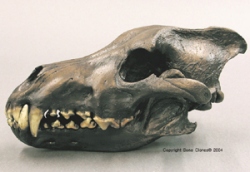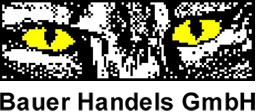Zoology: Bones (Fossil / Prehistoric)
Dire Wolf
Canis dirus
Dire Wolf Skull Tarpit Finish
Thriving during the Pleistocene, the dire wolf is not a direct ancestor of any of today's known species of canine. They co-existed in North America with gray wolves for about 100,000 years. Dire wolves had short, thick legs, a larger, broader skull and more massive teeth than the modern wolves. Their brain case is also notably smaller than their remaining canine cousins. Remains of over 3,600 individuals have been recovered from the La Brea Tar Pits - more than any other species of mammal. Licensed to Bone Clones® by the Natural History Museum of Los Angeles County, a portion of the sales goes to further their work.
A study conducted in 2020 and published in the journal Nature, examined ancient DNA samples from dire wolves (Canis dirus) and reveals a much more distant relation to modern grey wolves (Canis lupus) than previously thought. While similar in body shape and dental morphology, the
study reveals the two species were unable to interbreed with one another and suggests dire wolves represent a branch that split from other canids about 6 million years ago. This means that dire wolves will get a new scientific name, Aenocyon dirus, meaning terrible wolf.
2-part skull (separate cranium & jaw).
12 ½" L x 6 ½" W x 6 ½" H / 31.4L x 16.3W x 16.4H (cm)
A study conducted in 2020 and published in the journal Nature, examined ancient DNA samples from dire wolves (Canis dirus) and reveals a much more distant relation to modern grey wolves (Canis lupus) than previously thought. While similar in body shape and dental morphology, the
study reveals the two species were unable to interbreed with one another and suggests dire wolves represent a branch that split from other canids about 6 million years ago. This means that dire wolves will get a new scientific name, Aenocyon dirus, meaning terrible wolf.
2-part skull (separate cranium & jaw).
12 ½" L x 6 ½" W x 6 ½" H / 31.4L x 16.3W x 16.4H (cm)




Manufacturer:
| Bone Clones |  |
Note:
Matching base available on request (part no. S-BC-020T).
All prices plus VAT and shipping costs

